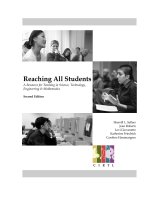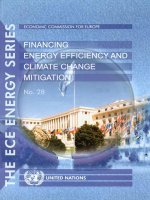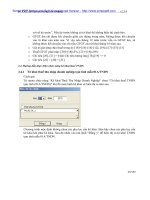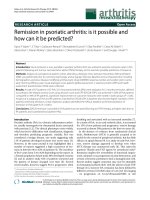- Trang chủ >>
- Mầm non - Tiểu học >>
- Lớp 5
5 4 3 a home for humans in outer space is it possible (space and technology) TG
Bạn đang xem bản rút gọn của tài liệu. Xem và tải ngay bản đầy đủ của tài liệu tại đây (118.12 KB, 4 trang )
A Home for Humans
in Outer Space
This book presents information
about research on deep-space travel and
the adaptations humans would have to make
to sustain long voyages. It explores benefits
and drawbacks of space travel and colonization. Information is included about early
space voyages and scientific research on
other planets.
SUMMARY
LESSON VOCABULARY
asteroids
contend
deflect
vegetation
astronomically
cycle
extraterrestrial
INTRODUCE THE BOOK
Discuss
with the students the title and the author
of A Home for Humans in Outer Space: Is It
Possible? Based on the title, ask students
what information they think this book will
provide. Do they think this book will provide
both sides of this issue? Why or why not?
INTRODUCE THE TITLE AND AUTHOR
Ask students to share
what interests them about space and space
travel. Ask what they think it would be like to
live in outer space. Do they think it’s a good
idea to explore space? Why or why not?
BUILD BACKGROUND
Build background for English language
learners by using a map of the solar system
and talking about space and space travel.
Have students
look at the photos, captions, and headings.
How do these text features help them know
how this book is organized? What other text
features can students find in this book?
PREVIEW/USE TEXT FEATURES
80
5.4.3
GRAPHIC SOURCES
MONITOR AND FIX UP
READ THE BOOK
Have students set a purpose for
reading A Home for Humans in Outer Space: Is
It Possible? Their interest in space and space
travel may drive this purpose. They may also
be interested in what the future holds for the
human race. Encourage students to think
about their purpose throughout their reading.
SET PURPOSE
Point
out to students that much of the information
in this book is technical and complicated.
Encourage students to monitor their comprehension by asking questions as they read.
(Do I understand this? Does this make sense?)
If students are having comprehension difficulties, encourage them to use a fix up strategy,
such as reading on, rereading and reviewing,
or seeking help from others.
STRATEGY SUPPORT: MONITOR AND FIX UP
COMPREHENSION QUESTIONS
PAGE 8 Why do scientists think Mars is the
most likely planet to support life? (A meteorite
that fell to Earth from Mars 13,000 years ago
appeared to have bacteria in it. Mars has, or
once had, water.)
PAGES 10–11 Why is zero gravity a problem
for humans? (People lose muscle and bone
strength; heart becomes inefficient.)
What are some of the benefits of
building space colonies? (Possible response:
Escape disaster on Earth. Helpful to have
experiments done in zero gravity. Learn how
to harvest solar power.)
PAGE 14
PAGE 15 What is the topic of the circle graph?
(global power consumption)
A Home for Humans in Outer Space
16924_LRD_TG_080-081 80
10/20/05 2:42:11 PM
REVISIT THE BOOK
READER RESPONSE
Skill Work
1. oil.
2. Responses will vary but should show an
understanding of centripetal force and use
common examples such as spinning a bucket of water in a circle.
3. performed
4. Student questions will vary. Possible
response: Possible source could include
International Energy Agency.
TEACH/REVIEW VOCABULARY
Have students look at
the picture on page 13. Discuss some of the
details they can see in the picture. Based on
this picture talk about what life might be like
on a space colony.
GRAPHIC SOURCES Remind students that
graphic sources are graphs, maps, photographs, and diagrams that help strengthen
their understanding of the text. Have students
read page 18 and then look at the chart. Ask:
What information is in the chart? How does
the chart add to what you read in the text?
EXTEND UNDERSTANDING
RESPONSE OPTIONS
Ask students what their opinions are
about space travel. Have students write a
persuasive paper about whether we should
or shouldn’t pursue space travel. Be sure
students include facts they learned from the
book to support their main idea.
WRITING
WORD WORK Asteroid and celestial are “space”
words. Encourage students to find other
space words in the text or on their own. Have
them draw a picture of the solar system and
include the words and their definitions.
SCIENCE CONNECTION
Have students explore space
by looking at the NASA web
site (kids.msfc.nasa.gov/).
Have students locate the vocabulary words
in the text. Have them define each word
using context clues, the glossary, and a dictionary. Then invite students to list for each
word as many words as possible that have
similar meanings or are related in some way.
TARGET SKILL AND STRATEGY
Remind students
that good readers constantly monitor, or
check, comprehension as they read. If the
text isn’t making sense, they can use fix-up
strategies, such as adjusting their reading
rate, reading on, or rereading and reviewing.
Have students read pages 6–7. Encourage
them to check their comprehension by working with a partner to ask each other questions and review the text.
MONITOR AND FIX UP
ADDITIONAL SKILL INSTRUCTION
MAIN IDEA AND DETAILS Remind students
that the main idea is the most important
idea about a topic. It is usually stated very
briefly. The supporting details are small
pieces of information that tell more about the
main idea. Have students read page 5. Ask
students what the main idea is. (Asteroids
can be dangerous.) Have them tell you some
supporting details. (Several thousand of them
in solar system. Could cause huge explosion
if collided with Earth.) Tell students that they
can think about both the main idea of a section of text and about the main idea of an
entire book. Encourage students to continue
to think about main idea as they read.
A Home for Humans in Outer Space
16924_LRD_TG_080-081 81
81
10/20/05 2:42:12 PM
A Home for Humans
Name
Graphic Sources
Graphic sources are graphs, maps, pictures, photographs, and diagrams that help strengthen
understanding of text.
Directions Using information you learned from the book, show the distance between Earth and the
moon and Earth and Mars. On the lines provided below the diagram write what scientists are learning
about life in space and questions they still have. Add questions that you have.
Moon
384,000 km
from Earth
Mars
Earth
227,936,640 km
from Earth
© Pearson Education 5
Space Station
82
16924_LRD_TG_082-083 1
10/20/05 2:42:58 PM
A Home for Humans
Name
Vocabulary
Directions Fill in the blanks in the sentences below with the correct word from the box.
Check the Words You Know
asteroids
contend
deflect
vegetation
astronomically
cycle
extraterrestrial
1. Scientists are studying ways to
before it hits Earth.
2. Astronauts must
debris from space
with many challenges presented
by space travel.
3. There are about 100,000
orbiting the sun.
4. The amount of money required to build a space colony is
large.
5. The moon is on a twenty-nine day
around the earth.
as it circles
© Pearson Education 5
6. Some people support space travel as a way to search for
life.
7. Human beings depend on
and food.
as a source of oxygen
83
16924_LRD_TG_082-083 2
3/20/06 8:47:10 AM









